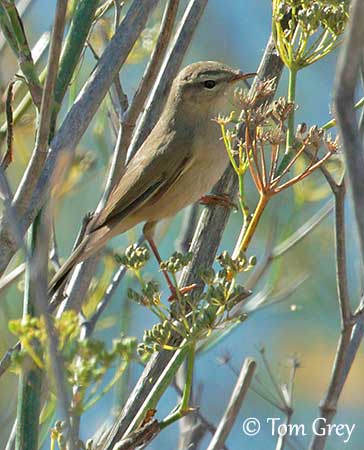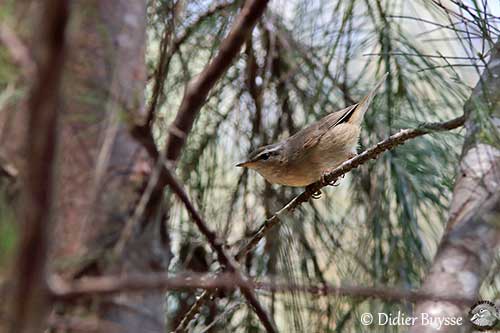
Fr: Pouillot brun
Ang: Dusky Warbler
All: Dunkellaubsänger
Esp: Mosquitero sombrío
Ita: Luì scuro
Nd: Bruine Boszanger
Sd: brunsångare
Photographers:
John Anderson
John Anderson Photo Galleries
Didier Buysse
Vision d’Oiseaux
Tom Grey
Tom Grey's Bird Pictures & Tom Grey's Bird Pictures 2
Text by Nicole Bouglouan
Sources:
HANDBOOK OF THE BIRDS OF THE WORLD Vol 11 by Josep del Hoyo, Andrew Elliott and David Christie - Lynx Edicions - ISBN: 849655306X
A Field Guide to the Birds of South-East Asia by Craig Robson. New Holland Publishers. ISBN: 9781780090498
What Bird-The ultimate Bird Guide (Mitchell Waite)
Polygyny in the dusky warbler, Phylloscopus fuscatus: the importance of female qualities
South Dakota Birds and Birding – (Terry L. Sohl)
Birds of the World - Dusky Warbler
Dusky Warbler
Phylloscopus fuscatus
Passeriformes Order – Phylloscopidae Family
INTRODUCTION:
The Dusky Warbler is a strongly migratory small bird that breeds in northern Asia and winters southwards in N India, Myanmar and Nepal. It may occur in North America, both in Alaska and California.
It frequents montane forests and thickets, bogs and wet meadows. This skulking species is more often heard than seen. It is very inconspicuous, but it is often betrayed by its calls. It feeds mainly on insects and various small invertebrates caught from the vegetation.
The nest, built by the female, is a sphere-shaped structure placed on or near the ground, at base of clump of grasses or other vegetation.
The Dusky Warbler is common to locally abundant throughout the range, and the species is not currently threatened.
DESCRIPTION OF THE BIRD:
Biometrics:
Length: 11-12 cm
Wingspan: 18 cm
Weight: 9-11 g
The Dusky Warbler of nominate race has dark brown upperparts in fresh plumage, becoming greyer in worn plumage. Rump and uppertail-coverts are slightly paler. Flight-feathers and rectrices are like the upperparts. Both are rounded and the tail is fan-shaped.
The underparts are dirty whitish with variable buffish wash on breast-sides, flanks and undertail-coverts. This tinge is more intense in fresh plumage. On the underwing, the coverts are buff tinged pinkish.

On the dark brown head, we can see a conspicuous, long, whitish-buff supercilium, becoming buff behind the eye. The broad eyestripe is dark brown to blackish.
The thin, pointed bill is dark brown, with paler base and edges of lower mandible. The eyes are dark brown, and surrounded by narrow, whitish eyering. Legs and feet vary from dark to pale brown or dull orange to pale yellow.
Male and female are similar.
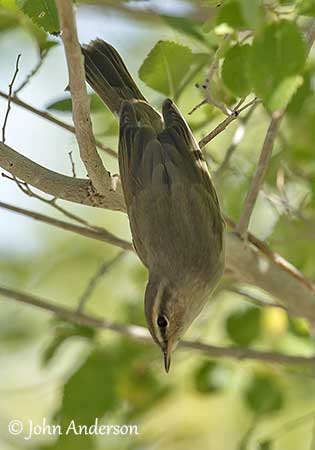
The juvenile resembles adult, with yellow wash on the underparts and more olive upperparts.
SUBSPECIES AND RANGE:
The Dusky Warbler has two subspecies.
P.f. fuscatus (described above) breeds in C and E Siberia, from R Ob E to R Anadyr Basin, S to Tomsk region, Mongolia, NE China, Russian Far East and Sakhalin.
Outside the breeding season, the species occurs in NE India, S Nepal, Bangladesh and S China, S to Andaman Is and Peninsular Malaysia, E to Taiwan and S Japan.
P.f. robustus breeds in NC China (Gansu and Inner Mongolia to N Sichuan).
It moves to N Thailand and Laos after breeding.
This race is not described, but the scientific name “robustus” probably describes a bird larger and bulkier than the nominate race.
HABITAT:
The Dusky Warbler breeds in taiga and boreal areas, usually in scrub and low vegetation, bushes, tall grass and thickets of willows and alders along streams. It also frequents bogs and wet meadows in marshy river valleys, and foothills and montane forests up to more than 4,000 metres of elevation.
Outside breeding season, it is found in foothills with scrubs, also in open plains with low bushes and trees, at edges of cultivated fields and in mangroves. It is frequently found near water.
On migration, it is mostly found in lowlands, but also up to 1,800 metres of elevation.
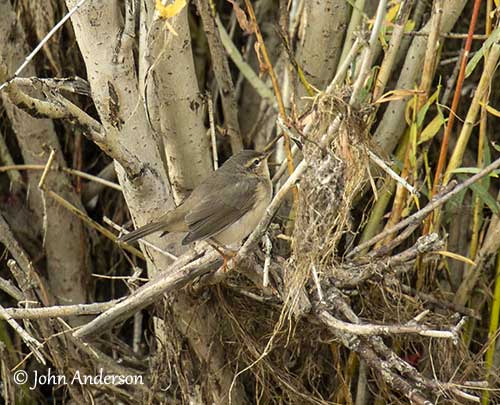
CALLS AND SONGS: SOUNDS BY XENO-CANTO
The Dusky Warbler gives a sharp, hard “tett” or “tak” often repeated when the bird is excited. This call may sometimes extend in a rattling series.
The song is a monotonous series of clear whistled phrases and trills, ending with a more rapid trilling. The song often starts with a thin “tsirit”.
BEHAVIOUR IN THE WILD:
The Dusky Warbler feeds mainly on insects and small invertebrates, molluscs, larvae, seeds and berries.
It is active while foraging by hopping and fluttering among the vegetation, usually fairly close to the ground. Insects are gleaned directly from the foliage or caught on the wing.
While foraging, it often flicks both wings and tail. It is very secretive and usually skulks in the low, dense vegetation.
It is generally solitary, but loose groups are observed on passage and in winter.
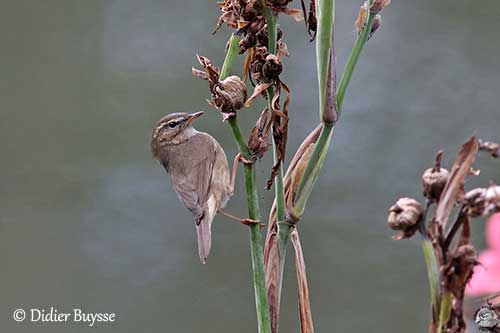
The Dusky Warbler is territorial during the breeding season. The song plays a very important role in territorial behaviour including defence of the nesting site and mate attraction.
The males with heavy, bulky bodies usually have better territories and attract more females. The females prefer to choose mates in good body conditions, based on the quality of their songs.
This species nests on or near the ground, in a dome-shaped structure protected by clump of grasses or other vegetation.
The Dusky Warbler is strongly migratory. The breeding populations of nominate race perform altitudinal movements and long-distance migrations. They leave the breeding areas in August/September and reach the foothills of Nepal from mid-October to late March. The species is present in India until April/early May.
They return from April to late May/early June. The Siberian breeding grounds are occupied from end of May.
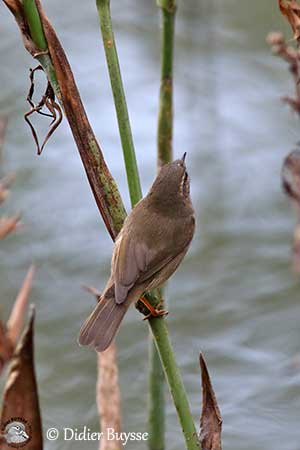
The Dusky Warbler is a widespread vagrant that also occurs in W Europe (Britain, Ireland and Netherlands), Israel, Cyprus, Egypt, Morocco and Madeira. In south, it can be seen to Sri Lanka, also E Japan, Philippines, and W North America (Aleutian Islands and Farallon Islands in California.
The flight is a short, weak fluttering flight with rapid shallow wingbeats.
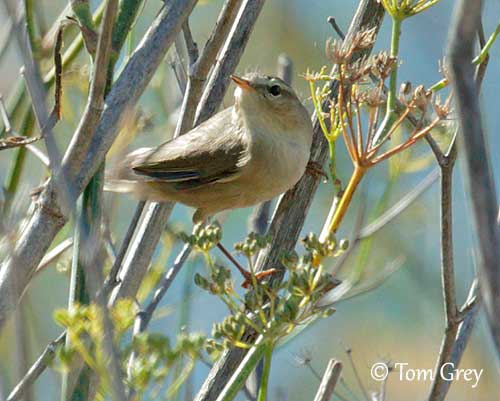
REPRODUCTION OF THIS SPECIES:
The breeding season takes place from late May to mid-August, with some variations according to the range.
This species produces a single broods per season.
The nest is built by the female, a dome-shaped structure with a side-entrance, made with grasses, leaves, moss and other plant materials. This nest is placed on the ground, usually protected by clump of grasses, willow scrub or other vegetation. It may also be placed up to 1 metre above the ground, on a branch in small shrub or tree.
The female lays 5-7 white eggs and incubates alone during 11-12 days. Both parents feed and rear the young that fledge about 15 days after hatching.
PROTECTION / THREATS / STATUS:
The Dusky Warbler is described as common or locally abundant throughout the range, except in Malay Peninsula where it is scarce to uncommon.
The size of the population is unknown, but it is suspected to be stable, in absence of evidence for any declines or threats.
The Dusky Warbler is not globally threatened and the species is currently evaluated as Least Concern.
